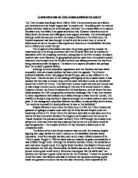To what extent was superior military leadership the reason for success in the first Crusade?
To what extent was superior military leadership the reason for success in the first Crusade?
In July 1099 the First Crusade succeeded in its objective and captured the holy city of Jerusalem. The leadership provided by key figures such as Bohemond of Taranto, Raymond of Toulouse and Adhemar of Le Puy was of key importance. Bohemond was an able general whose aggressive tactics created the victories over Ridwan and Kerbogah, while Robert of Normandy was a vital military commander who rallied the troops at Dorylaeum and leading the charge at Ascalon. They led the crusading armies to victory in sieges at Nicaea, Antioch and Jerusalem and battles at Dorylaeum and Antioch. Adhemar played a key role in uniting the lay princes – as is shown by the near collapse of the crusade after his death at Antioch. Other factors which contributed to success include the divisions within the Muslim world with the fragmentation of the Seldjuk Empire after 1092, and tensions between Turks and Arabs, Fatimids and Abbasids and Sunnis and Shias all aided the crusaders. The role of Byzantium also contributed to the success of the First Crusade – in particular the provision of supplies during the crossing of Anatolia and at Antioch, where the Byzantine fleet proved vital, religious zeal – and the attraction of Jerusalem provided drive, determination and ideological cohesion which proved vital at Antioch in particular.
Candidates may discuss some of the following in relation to ‘strong leadership’: the role of Urban II in galvanising support; the role of the papal legate, Adhemar of Le Puy ; the roles of Raymond of Toulouse, Bohemond of Taranto, Godfrey of Bouillon, and to a lesser extent Hugh Vermandois, Robert of Normandy, Stephen of Blois, Baldwin and Tancred. Such discussion may in fact argue that leadership in terms of central control and clear direction was not always strong and point to the tensions between leaders (particularly over Antioch). On the other hand they may point to the strong military leadership given by able commanders like Bohemond and the degree of cooperation and common purpose organised by the ‘council of princes’ at crucial times. Such discussion needs to be balanced against other reasons for the success of the Crusade, such as: religious zeal (and its demonstration at key points, for example at and after Antioch and at Jerusalem), military strategy, tactics and successes (such as Dorylaeum and the defeat of Kerbogha), tensions and disunity amongst opponents (Shi-ite Fatimids and Sunni Seljuks, mutual rivalries between Aleppo, Damascus, Mosul and so on), and the aid given by Emperor alexius








